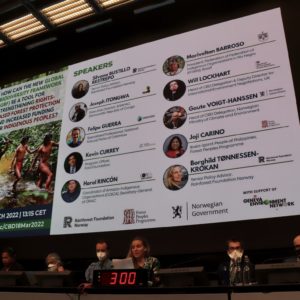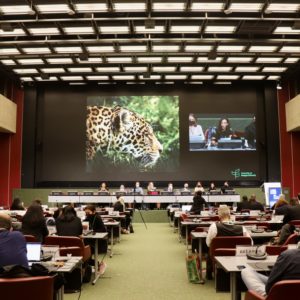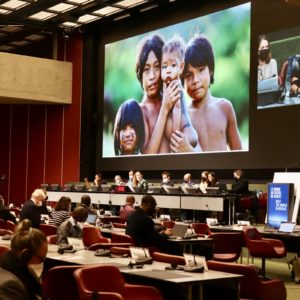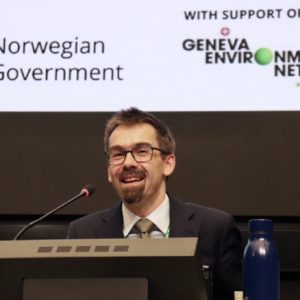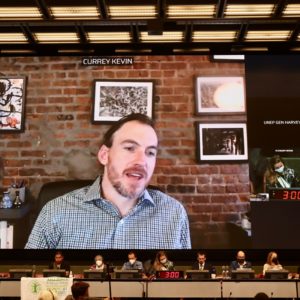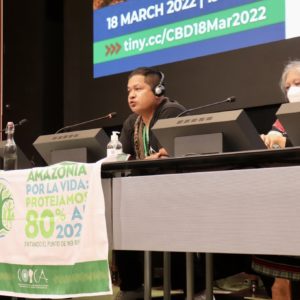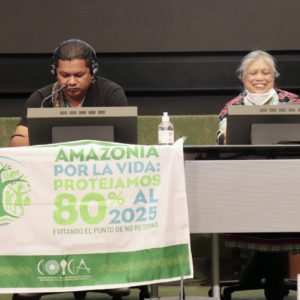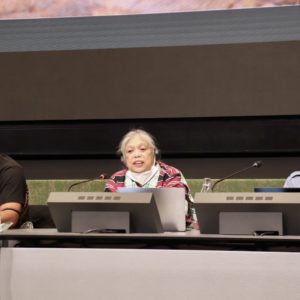Event Conference
CBD Side Event | How Can the New Global Biodiversity Framework (GBF) Be a Tool for Strengthening Rights-Based Forest Protection and Increased Funding for Indigenous Peoples?

18 Mar 2022
13:15–14:45
Venue: CICG Room ABC & Online
Organization: Forest Peoples Programme, Norway, Rainforest Foundation Norway
This hybrid session was a side-event to the Convention on Biological Diversity (CBD) resumed sessions of the twenty-fourth meeting of the Subsidiary Body on Scientific, Technical and Technological Advice (SBSTTA 24), the third meeting of the Subsidiary Body on Implementation (SBI 3) and the Open-ended Working Group on the Post-2020 Global Biodiversity Framework (WG2020-3), taking place in Geneva, in March 2022. The side-event was organized by the Rainforest Foundation Norway, Forest Peoples Programme and the Government of Norway, with the support of the Geneva Environment Network.

About this Session
One of the key elements in a new Global Biodiversity Framework (GBF) will be how the frameworks’ goals, targets and implementation system can incentivize practical biodiversity solutions on the ground. There is a large overlap between indigenous peoples’ areas and areas with very high biodiversity, both in tropical forests and other biodiversity rich ecosystems. How can a new GBF best support the key role and respect the rights of indigenous peoples and local communities (IPLC)?
Examples from rainforest countries, which – when scaled up – have the potential to make globally significant contributions to the conservation and sustainable use of biodiversity, will be presented at this side-event. Key questions in the discussion will be how the new agreement and its implementation mechanisms should be formulated to ensure support and enhancement of IPLC contributions. Significant opportunities arise for using scant public and private resources in ways that can address the climate and biodiversity crises together, and opportunities to build on significant pledges already made at COP26 of the UNFCCC. Funding agencies will provide their perspective on how a new GBF best can incentivize increased funding for IPLC solutions.
The purpose is to come up with concrete input to formulations in the new GBF, as well as its implementation and monitoring systems, ensuring the rights of indigenous peoples and building actions and programs on their vast experience and knowledge in sustainable forest management, not only in area-based conservation targets but across the GBF.
Rainforest Foundation Norway (RFN), Forest Peoples Programme (FPP) and the Government of Norway have long experience in bringing actors from different sectors of society together – policy, finance, industry, indigenous peoples, CSOs –and are certain that this can lead to unexpected concrete suggestions and solutions needed now.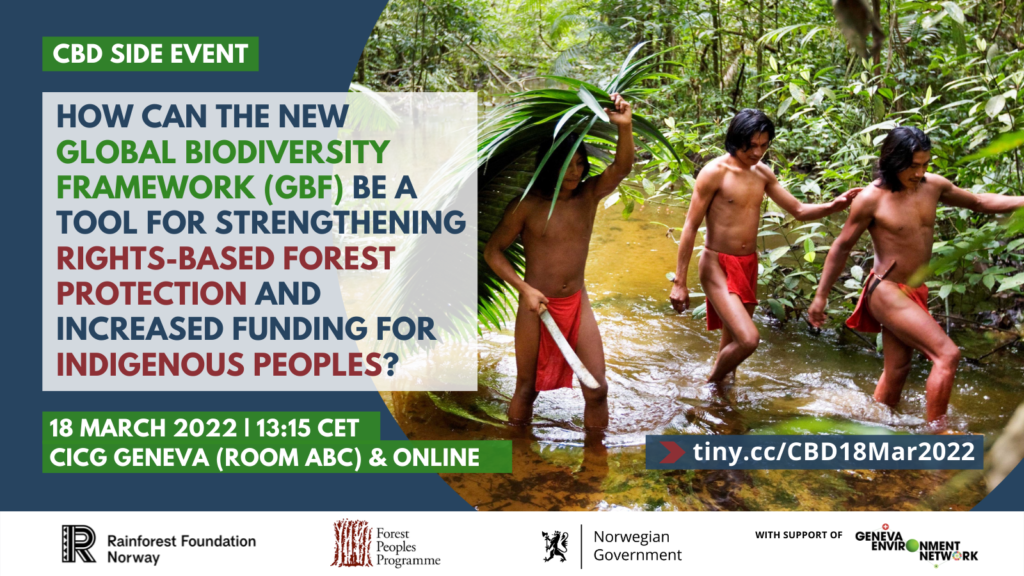
Speakers
By order of intervention.
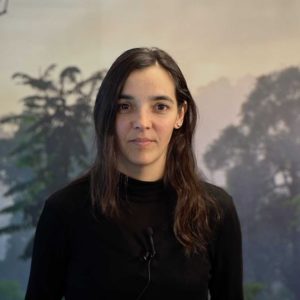
Silvana BUSTILLO RESTREPO
Senior Policy Advisor, Rainforest Foundation Norway
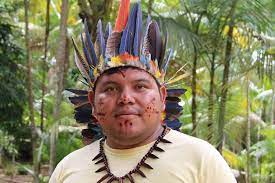
Marivelton BARROSO
President, Federation of Federation of Indigenous Organizations in Rio Negro (FOIRN), Brazil | Video Message

Joseph ITONGWA
Executive Director, ANAPAC, Democratic Republic of Congo | Video Message

Will LOCKHART
UK Head of CBD Delegation and Deputy Director for International Environment Negotiations
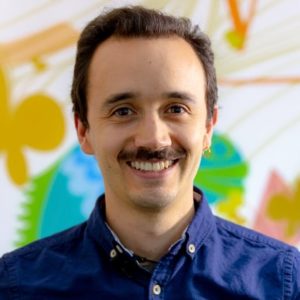
Felipe GUERRA
Specialized Professional, National Natural Parks of Colombia
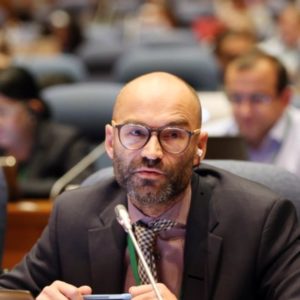
Gaute VOIGT-HANSSEN
Head of CBD Delegation, Norwegian Ministry of Climate and Environment

Kevin CURREY
Program Officer, Ford Foundation

Joji CARINO
Ibaloi-Igorot People of Philippines, Forest Peoples Programme

Harol RINCÓN
Coordinator of Amazon Indigenous Organizations (COICA), Secretary-General of OPIAC

Borghild TØNNESSEN-KROKAN
Senior Policy Advisor, Rainforest Foundation Norway
Summary
Borghild TØNNESSEN-KROKAN
- Welcome to this side-event on how to reach biodiversity goals through indigenous rights and forest management. It is my honor to be your host for this hybrid event that Rainforest Foundation Norway is co-hosting with the Forest Peoples Program and the Government of Norway, and streamed with the support of the Geneva Environment Network. We will hear from an extraordinary panel that I will introduce shortly.
- After two years of covid-19 delays we are finally live here from Geneva at the United Nations negotiations for a new Global Biodiversity Framework, to be adopted in Kunming China later this year under the Convention of Biological Diversity, shaping action urgently needed for this crucial decade: Because nature is declining at a speed that scientists have never previously seen.
- Today, more than half of the world’s species are in the ancient, precious tropical rainforests. Rainforests regulate climate, provide water, food and other goods and services we need to survive. Sadly, the world’s rainforests are severely threatened. We’re crossing environmental thresholds. Scientists warn that tipping points lead to abrupt and possibly irreversible shifts. So, how do we get out of this mess? How do we solve this?
Although it is well documented that biodiverse indigenous lands are often the best conserved, Indigenous peoples receive less than 1% of climate finance.
- At the climate summit in Glasgow, world leaders and climate finance contributors pledged to change this. Some of those are here with us today, as are indigenous peoples and civil society. Our first speaker is a conservation biologist and senior policy advisor at the Rainforest Foundation Norway. She will talk about how and why rights-based rainforests management is key to protecting biodiversity, finding workable solutions.
Silvana BUSTILLO RESTREPO
- Rainforest Foundation Norway is an international NGO with 30 years of experience working on rights-based rainforest protection in several major rainforest countries. We partner with civil society and Indigenous Peoples (IP) organizations, governments, and other stakeholders around the world to ensure that the world’s large contiguous rainforest areas are managed in ways that uphold biodiversity, forest ecosystem services and human rights of indigenous and other forest-dependent communities.
- Our data shows that today only 1/3 third of the tropical rainforests are intact, while the rest is either degraded or completely destroyed. There is no doubt on the importance of protecting these remaining irreplaceable ecosystems.
- Despite the increasing threats from the outside world to their lives, lands and rights, indigenous peoples and local communities in the Amazon and elsewhere continue to protect and manage their forests sustainably.
- Scientific studies show that areas, where indigenous peoples have recognized rights, are significantly more effective at halting deforestation and protecting biodiversity than other protected areas. Thus, indigenous peoples’ areas and forest governance systems are a good part of the solution when addressing the biodiversity and climate crises, especially in three major rainforest biomes – the Amazon, the Congo Basin and Southeast Asia.
- The solutions are there but need support. Let me give you some examples:
- 22% of the Brazilian Amazon Forest is within legally recognized Indigenous territories, for which many IP have developed their own management plans, or “life plans” as they call them. Supporting the implementation of these plans can be a huge contribution to biodiversity conservation.
- In the Democratic Republic of Congo, recent developments towards the recognition of indigenous peoples’ rights are a great step forward for rights-based forest management. Together with the Forests for Life partnership, we are developing a facility to ensure support for indigenous peoples’ management and thus the protection of large intact forests.
- In Indonesia, Indigenous peoples had a huge victory some years ago when “indigenous peoples ancestral lands” were officially recognized by the Supreme court. Since then, they have been mapping and seeking formal recognition for their specific territories. Together with social forestry initiatives by local communities and government, this has the potential to maintain the ecological integrity of Indonesia’s remaining rainforests.
- In Peru, the Wampis Nation’s territory constitutes a highly intact forest in the world’s most biodiverse region. Highly deforested areas both North and South of it underline the urgency of supporting their efforts to govern and protect their lands. The Yavari-Tapiche corridor -also in Peru- needs urgent action to protect both its irreplaceable forests and the isolated indigenous peoples that inhabit them.
- Deforestation, forest fragmentation and degradation are increasing and destroying some of the most biodiverse parts of the world that lies within Colombian territory. Nevertheless, Indigenous peoples are taking very impressive initiatives to save their forests. After obtaining the support of a presidential decree in 2018, these communities now work towards ensuring that up to 24% of the Colombian Amazon forests are managed and governed by Indigenous Local Governments. With support, they will secure almost 165,000 km2 of entirely intact rainforests and their vast biodiversity.
- We see more and more initiatives for biodiversity and climate solutions coming from IPLCs around the globe, like the very impressive proposal by COICA to protect 80% of the Amazon by 2025 that was put forward at the IUCN conservation congress.
- Despite their great contributions to protecting the world’s biological diversity, forests and with them the provision of invaluable ecosystem services that we all depend on, only less than 1% of the total funding available for climate and environment reaches local communities or IP organizations.
- We are really excited to see that IPLCs are being discussed at this meeting with a lot of proposals on how to make sure that their huge contributions and their rights are recognized.
- Their territories are under a lot of pressure, but there is no doubt that the most effective approach to stopping the loss of rainforests, is to recognize the tenure rights of the communities living there and support them in their management. With legally recognized tenure, they can more effectively monitor their forests to keep intruders out, they can challenge land grabbing and competing land claims, and they can use the forests according to their customs.
- This meeting is an important opportunity to support IPLCs governance through formal recognition of their rights. The GBF and its implementation mechanisms MUST provide the political and financial support needed to carry out and scale up the implementation and impact of these solutions.
How can the Global Biodiversity Framework boost concrete results for rights-based forest protection and increased finance? To help answer we have a great panel here: Key Indigenous Peoples representatives from the Amazon and the Philippines, Governments of the UK, Norway, and Colombia, and on a videolink from the US Ford Foundation that have all pledged to help end deforestation partnering with indigenous people, local communities and civil society in a rights-based manner.
- Stating with Will Lockhart, Deputy Director for International Environment Negotiations, Head of the CBD delegation of the United Kingdom. The United Kingdom hosted the climate summit in Glasgow late last year, where leaders pledged in two separate statements to end deforestation by 2030 and increase support to indigenous peoples and local communities, quite historic.
Will LOCKHART
- I will start by saying that the UK recognizes the vital role that Indigenous Peoples and local communities play around the world as guardians of nature and biodiversity, which is why we were so keen to put nature at the heart of COP26 but also keen to put IPLCs at the heart of COP26. We took IPLCs to the heart of this world leaders’ event and set the stage set both for the world leaders and for the indigenous representatives that were there.
- We were really delighted at COP26 that 23 country and philanthropic donors came together to launch a 1.7-billion-dollar commitment to advance IPLCs forest tenure rights. That is all money that is to be spent out to 2025, a relatively short period of time to spend a significant amount of money.
- Of course, money is not the only thing that matters, and it was not part of our agenda. We also put out a donor statement that underlines some of the messages that we are hearing in the conversation around the GBF which is the critical role of IPLCs as guardians of forests and nature and making sure that they can participate effectively as partners in decision making.
- Some of that funding of .7-billion-dollar is going to be channelling support to IPLC’s for capacity building, for sustainable livelihoods, and for creating the kind of governance structures that enable IPLCs to engage in the kind of conversations that we are having here.
- The funding will also be directed towards activities to secure land and resource rights, dispute resolution, conflict mechanism resolution, activities that will help on the ground to unlock some of the land rights that so many IPLCs suffer from.
- The other key moment at COP26, for those of us who follow biodiversity issues, was the fact over 140 leaders representing 90% of the world’s forests have pledged to halt and reverse forest loss by 2030, and that includes a significant level of finance. We got $12 billion dollars of climate finance out to 2025 to support that pledge, and another $1.5 billion dollars to protect the forests of the Congo.
Numbers are only one part of our approach. We want to bring some of that momentum around the finance to the negotiations here, but we also want to get into some of the important epistemic and structural issues that the GBF is perfectly designed to do and that will be taking quite an active role in the coming days.
Kevin Currey is the program officer at the Natural Resources and Climate Change team of Ford Foundation, where he focuses on helping indigenous people and local communities secure their lands and resource rights, and on realizing the potential of forest and land use to mitigate climate change and benefit low-income rural communities. Ford Foundation was also one of those behind the IPLC pledged at the climate summit in Glasgow
Kevin CURREY
- I see three overlapping paradigms for conservation. There is the old paradigm of fortress conservation where indigenous peoples and local communities are antithetical to the goals of protecting nature. Thankfully, we are trying to leave that in the past. The paradigm that I would say we are in at the moment, is what I would call inclusive conservation, where we recognize that yes, Indigenous Peoples and local communities are relevant for conservation and maybe they have some useful local knowledge that we could include and, I guess, they can participate if we train them and strengthen their capacity and get them to understand what it means to be good conservationists.
- Then, there is the paradigm that I hope we are moving towards in the future, and that is what I would call effective conservation. It starts with the recognition that it will be impossible to conserve biodiversity without the active involvement of indigenous peoples and local communities. And you reach that conclusion simply by looking at the evidence. IPLCs are more effective on balance than any other strategy. You can look at the that 80% of biodiversity is in indigenous lands that more than one-third of the world’s intact forests are indigenous lands, and you can look at satellite images comparing indigenous and local community territories and the quality and carbon storage of their forests with neighbouring forests and adjacent areas, including in protected areas. We know that they are effective, but we must ask why what makes indigenous peoples and local communities effective and the building block for their success has to be the formal recognition of customary land and resource rights. It is that security of tenure which allows indigenous peoples and local communities to manage their forests and other ecosystems sustainably.
- One of the reasons that Ford Foundation was happy to join the UK Government and others in committing to this 1.7-billion-dollar pledge in Glasgow, was because the fundamental basis of that was a recognition that we have to invest more in securing tenure for indigenous peoples and local communities, and that one really effective way of doing that is by getting money out to the communities themselves to support activities they are already doing on the ground, in their forests, on their territories to protect them. I think it is notable that the Protecting our Planet Challenge, which is a coalition of donors and conservation groups focused on biodiversity conservation, joined this pledge. They committed 100 million dollars over the next five years to support indigenous and local community tenure. That is really exciting and that shows that the paradigm is starting to change and, I hope, moving from inclusive to effective conservation.
I am counting on all of you there in Geneva to get this message out. That it is not enough just to talk about the knowledge and participation of Indigenous Peoples and local communities. Their rights have to be at thecenter. Their voices have to be at the center. And we have fund the work that they are already doing because they have been subsidizing the rest of us through their efforts to protect forests and ecosystems. It is now time to pay our fair share.
Gaute Voigt Hanssen is Head of Norway’s CBD Delegation from the Ministry of Climate and Environment and has been very active on rights-based rainforest protection.
Gaute VOIGT-HANSSEN
- Indigenous peoples are a key human rights issue for Norway, internationally as part of climate biodiversity and development policies, as well as domestically, regarding the Saami people which are indigenous to Norway.
- Norway’s commitments in this regard are defined by the UN social, cultural, and political conventions. Most importantly, by ratification into Norwegian law of the ILO Convention in 1989, and support for the Declaration of Human Rights on Indigenous Peoples adopted by the UN General Assembly in 2007.
- Norway is also a major financial supporter of Indigenous Peoples on a global level. During the last decade, Norwegian support to indigenous people’s role and actions towards limiting and adapting to climate change and maintaining biodiversity has largely happened as part of the Norwegian International Climate and Forest Initiative (NICFI), but also significantly through promoting resolutions in support of Environmental Human Rights Defenders in the UN Council on Human Rights.
- About the Global Biodiversity Framework, which we are here for, we think participation is key from indigenous peoples, as well as respecting rights and, of course, also benefiting from the suit stewardship of indigenous peoples is also key. This should be reflected in the Global Biodiversity Framework.
- We now have a conversation about how to approach this because indigenous people’s issues are both cross-cutting issues in the whole GBF, but we also have conversations on how this should be reflected in many of the targets. Target 3, on protecting at least 30 per cent of land and oceans, is an example of that.
- We also see other connections. For instance, there is a lot of talk about the implementation mechanism which will be important to prevent Aichi from happening again. We need to get the implementation right. So, when states are going home after Kunming, and they will write their NBSAPs, it is important that indigenous people’s issues are a part of that conversation going there.
- We also work for a global stocktake together with the UK and other partners and the effect we hope for is a ratcheting effect in the next 20 or 30 years, which will constantly improve the performance of states. And the indigenous peoples will also be key in this global biodiversity stocktake, as well as the NBSAPs which will bring us, hopefully, this ratcheting up.
After Brazil, Colombia is the most biodiverse country in the world, with its precious rainforests teeming with life. Felipe Guerra is a Specialized Professional from National Natural Parks of Colombia.
Felipe GUERRA
- I would like to talk to you about the grounded experience that we have been having from National Parks in Colombia regarding rights-based rainforest conservation and management. We have an important history in the coordination with IPLCs. This is framed in one law from the 1970s that allows National Parks to overlap with indigenous reserves. As such, we built a policy that is called the policy for the Social Participation in Conservation. Based on this policy, we have been developing special regimes of management and also use and management agreements with the ethnic territories. I say ethnic because we have both Native American and Afro Colombian so we can make the differentiation. 25% of the National Parks in Colombia overlap with ethnic territories, and 41% are neighbours with ethnic territories, making a total of 66% of the National Park system as such. For all those cases we design, agree, and sign special management agreements with full participation and consent with indigenous peoples. To make this work we have a program called Special Strategies of management, with which we guarantee rights-based participation of IPLCs since the moment one of the creation of a protected area. For example, when we relate with indigenous reserves or territories of Afro Colombian communities, we do it having in mind that they are equal public authorities as we are. We are a public authority; they are the public authority over their territory. So, we are equal, and we too treat each other as equal.
- We have each comma, each word of the management plan of Sierra Nevada de Santa Marta National Park, and Tayrona National Park agreed and written with the four indigenous peoples of the Sierra Nevada and Santa Marta. We have a management plan for two protected areas of about 600 pages. Every page was written and agreed with them. We call this our marriage, and we joke a lot about it. We have other cases like Yaigojé Apaporis National Park, where Indigenous Reserve Yaigojé Apaporis called National Parks like “Hey guys! we need to create a National Park that overlaps 100% with our indigenous reserve to protect us from mining companies”. We also have a policy to ensure the rights of isolated indigenous people to remain uncontacted and isolated. For the cases such as Chiribiquete National Park or Río Puré National Park, there are cultural conservation objectives.
- Finally, we have a new policy for the system of protected areas to 2030. The first thing we did was analyze that there is not enough biodiversity represented in the national system of protected areas, and there is not all the cultural heritage also represented over there. So, we thought we must involve indigenous communities.IPLCs as such to guide us with the indigenous and local knowledge for the creation of protected areas. So, we have conservation objectives driven by cultural objectives as well. Second, we want to create the community management protected areas category. So, indigenous have the right also to create their own type of categories that adapt to their own system of beliefs. All this is done in close collaboration with the indigenous peoples, resulting in very beautiful work. Sometimes we face some difficulties to make viable the coordination structures due to capacity building but also resource mobilization. These issues must be addressed, but regarding capacity building, many times well the indigenous people already know how to protect their territory. It is unnecessary to explain anything besides the use of technological tools such as GPS. That is why many times, as in the Katío National Park, 90% of the staff is from the Indigenous and Afro Colombian communities so we guarantee also the inclusion of them inside our institution.
Harold Rincon, is Coordinator of biodiversity and climate change for Amazon indigenous peoples organization COICA, Secretary-general of OPIAC
Harold RINCON
- Greetings on behalf of our traditional authorities of the nine countries that are part of the COICA and from the Maguta peoples. For us to protect biodiversity and try to mitigate and adapt, we need two things. First, we need governments to demand the guarantee of the right of access to indigenous land, which belongs to indigenous peoples by origin.
- The second thing we need has already been recognized in the Paris Agreement: the system of Indigenous Knowledge. Indigenous knowledge is not “traditional knowledge”, rather something even greater at the same level of domains like science and philosophy.
- Only by recognizing the life systems, food systems, art, the way we perceive the world the indigenous communities are empowered to do what is necessary to protect our biodiversity and adapt to climate change.
- In terms of the land, we need 100 million hectares in order to fill all these gaps that are not legally clear in terms of territorial ownership. That is what COICA has been fighting for: if we want to protect our territory, we need to have the appropriate legal protection.
- For this recognition, we need government systems that have the same capacity as any government. In the case of Colombia, for example, through the Constitution of 1991, the indigenous territories ownership has been granted, unlike any other basins in the Amazons. A tool like this one is needed to protect our biodiversity. Indigenous peoples’ along with the support of standards, norms, and more territorial based systems is necessary to achieve Target 3.
- In terms of space, we are questioning the role of the financing and all this. Why is financing going towards certain areas and not for land ownership? COICA has been working in Latin America to identify where the deforestation and degradation of the Amazon Basin are happening: over 40% is protected, but in most cases, there is a capacity gap to protect those large areas. This is also connected to the deforestation-led fires that happened in indigenous territories, corresponding to 7% of these, but which are not considered statistically as factors of degradation, but rather as are considered natural factors of degradation. So, we demand full recognition of the role of the knowledge of the systems of Indigenous People’s Knowledge that is at the front of any scientific achievement. Rio Voladores, for example, has recently been recognized by the Scientific Community to regulate the rains from South America to the North and most countries in the North benefit from that.
- We have always known that, but scientists have only discovered that a few years ago. So, there is the connectivity with the Andes and the Amazon and Rainforest, with the Atlantic Ocean, and with the deserts. We have always had this knowledge, but we need governments to materialize indigenous peoples’ rights so that we can protect knowledge, protect biodiversity and complete this mitigation package and action for climate change.
The next speaker is Joji Carino, Ibaloi-Igorot People of Philippines and representative of the Forest Peoples Programme.
Joji CARINO
- This side event has given a comprehensive picture of how Indigenous Peoples and local communities are addressing biodiversity laws, climate change, and social inequality in our communities, countries, and globally. The Local Biodiversity Outlook 2 is a source of this repository of these stories: a complimentary report launched together with the CBD’s Global Biodiversity Outlook. Over 50 authors from organizations of Indigenous Peoples and local communities reported on their collective actions and how have contributed to the Strategic Plan for Biodiversity 2011-2020 and the Aichi Biodiversity Targets. Here are some of the main findings from the Local Biodiversity Outlooks:
- The Aichi Biodiversity Target 18, focused on Indigenous Peoples and Traditional Knowledge, has not been met. Only 10% of parties directly engaged indigenous peoples and communities in their national biodiversity strategies and action plans. Such ongoing disregard for the vital contributions of IPLCs was a major missed opportunity in the past decade and this must be corrected in our current negotiations of the Post-2020 GBF. We believe that this will deliver strong sustainable livelihoods and wellbeing, as well as positive outcomes for biodiversity and men.
- What are the key priorities?
- Under goal A, Conservation, we must secure the customary lands of Indigenous Peoples and local communities. This must be embedded in Target 1 on Special Planning and Target 3.
- In Goal B on Benefits, parties must start implementing the Global Plan of Action on customer sustainable use, already approved by the COP but which has not yet been implemented. This will ensure that these benefits really flow both to us and to the world.
- In terms of Goal C, Benefit Sharing apart from Genetic Resources, Payment for Ecosystem Services, Biological Resource, Digitalization and DSI.
- And finally, in governance truly rewarding effective indigenous solutions and stopping the destruction of unsustainable activities.
- There is a paradox of funding for indigenous peoples with a promise of ever-increasing funds, but very persistent in accessibility to these funds, which continue to flow to big organizations and to governments. This leaves only a small percentage of these truly accrue for our collective actions and this must be seriously addressed in the current Global Biodiversity Framework.
Q. Both UK and Norway were involved in the work during this week at the United Nations in Strengthening Implementation in the Global Biodiversity Framework. Many panellists mentioned several challenges in ensuring customary land financial flows in the right direction. The question is about implementation and monitoring: how do we ensure that we walk the talk?
Will LOCKHART
- It is absolutely critical we think about implementation and monitoring now before we agree on the Framework itself and we have a credible plan in place for making sure that that can happen. We need transparency, reporting, comparability, a global stock tape process, a ratchet mechanism. With reference to the points made in the panel today, the key one is that we, negotiators, have to listen to the voices that are around us. Despite at the government level we can find and announce money, we do not have the necessary instruments to ensure it flows. The challenge is to build our own capacity to listen and engage and understand that there is something beyond the indicators we deem right. Customary knowledge and the idea that actually IPLCs can monitor their own land shows that guardians of the local culture will know those far better. It is therefore fundamental that these points and the languages and attitudes in which these are expressed are properly reflected in the framework.
Q: How should the role of IPLCs be reflected in the Global Biodiversity Framework and how do we ensure its implementation?
Gaute VOIGT-HANSSEN
- The IPBES report is the foundation for the whole Global Biodiversity Framework and the theory of change is embedded in the document. The main message from IPBES highlights the importance that indigenous peoples play as stewards of the land. It also states that indigenous peoples’ lands are in much better shape than other land areas. That tells us that it is well worth looking at what indigenous peoples actually have done right. Regarding the monitoring system, we are working on Global Goals and Targets to ensure indigenous peoples’ interests are reflected properly in the relevant targets, but also in the monitoring system. To that end, we are working on headlines and specific indicators.
- IPLC’s interests are really important as well when these indicators are shaped, as these indicators will tell us how we progress in the Global Goals and Targets. Another important aspect of the Global Biodiversity Framework is the sustainable use one, in which customary sustainability will be addressed. Regarding finance, it is likely that better targeting of IPLCs may be a more effective way to get results.
Q. Felipe, you talked about the laws and the policies that Colombia has in place to protect both the Rainforest and also it is indigenous people and empower its indigenous people. You mentioned also the partnership between the two and used the word “marriage”. Harold, is it a happy marriage? Given that there’s no secret that Colombia is exiting after years of conflicts with and as consequence also both, deforestation and other violations.
Harold RINCON
- What a question. Yes. Couples are always very complicated in all situations. But now in Chiribiquete National Park of 3 million hectares, the rate we have now of deforestation is one thousand hectares per day in an area that does not have a good connection with the centre of the country. So, now, how are you going to implement what the constitution and the environmental law is proposing? In Colombia, we say we have the most solid constitution for environmental matters, and if we compare the protected areas in Colombia, with other areas, by law, we protect all the areas. We cannot allow any extractive activities for instance. And since as indigenous peoples we do have land ownership, there is a problem. And in the Colombian Amazon, we have a problem with another park that is protected but that had to be moved to a protected area to avoid the Canadians from coming to exploit gold. This situation must not become the norm.
- We also have a very special regime for management. So, the rules are there but there are also many large political interests that sometimes go against these goals. For instance, in Guaviare, there are many rural activities that are part of the Amazons, but the policy by the local government, the sub-national government, is to do the contrary to these goals and of indigenous peoples. What I am trying to say is that you are asking me about the case, yes, we do have rules and laws, but the issue is how do we manage for each of the governments to implement in the most efficient way what the rules and the laws are saying, and that is where we have this gap. I would call it a gap that goes against all our conservation efforts.
Felipe GUERRA
- There is some work to do. For example, at the sub-national level, in Santa Marta National Park, the management plan that we have, does identify as pressure the development model that is being implemented by sub-national governments. They prioritize, for example, livestock or palm Africana as Harold was saying. This does not correspond with the boundaries of the National Park. So many times it creates pressures and, what you can see in some of the resolutions we have signed with indigenous peoples from Chiribiquete National Park boundaries, is that we argue that if their territory is strengthened, the National Park is strengthened, and if the National Park is strengthened, their territory is strong and everyone wins. Society wins.
- In National Parks, Cerania, Chiribiquete, which Harold was mentioning, we have unfortunately so much deforestation and there are so many political and economical interests that sadly have many pressures, many illegal actors in territory. In Chiribiquete National Park and in the boundaries, there are about twenty-one Indigenous Reserves neighbouring, if I’m not wrong, and one overlapped. So, if you strengthen those indigenous reserves, there is no way deforestation is going to come in. They preserved Chiribiquete as the biggest secret of Colombia for thousands of centuries. We only discovered Chiribiquete in 1987.
Kevin CURREY
- The discussion about Colombia is an interesting illustration of the fact that these issues are going to play out on the ground in specific countries and more than that in specific territories. And so it is all well and good to have a global framework that guides the direction of action. But the real work is going to be at the country and sub-national level. And that is where it is especially important to make sure that indigenous peoples and local communities have a seat at the table and that they are developing good relationships with the government.
- The government is seeking their free prior and informed consent for conservation activities, and governments are recognizing that indigenous peoples and local communities have been leading the way in conservation. If governments really want that they are committed to biodiversity, conservation, as well as to climate mitigation, the best way to do that is to respect the land and resource rights of indigenous peoples and local communities and to help formalize the contribution that those communities are making both to storing forest carbon and reducing emissions from deforestation but also to protecting biodiversity.
- The last thing I want to say is just to underscore an important point that Joji made and I think what we can say is that even if we are successful in getting the rights of indigenous peoples and local communities recognized across the world. That is not sufficient, and we really need to be investing in communities and in their self-determined economic development models in their forest monitoring and forest guardianship practices to make sure that the gains that they have in terms of protecting ecosystems and biodiversity are sustained. And the current system we have for financing this work is highly inefficient because we have taken the path of least resistance to put money into large organizations assuming it will trickle down to the ground. And that is leading to a lot of losses and efficiency and effectiveness. We need to build a better architecture that allows us to get money right out to the grassroots organizations to the people in communities that are actually doing the physical labour involved in protecting forests and ecosystems. What I am really excited about is that lots of indigenous and community organizations are starting to build their own funds and financing mechanisms that would allow them to receive finance, and certainly, the Ford Foundation side part of our involvement in the $1. 7 billion dollar pledge in Glasgow was motivated by a desire to think about new ways of getting money out to local communities including to their ongoing efforts to conserve biodiversity. I think that is going to be a really exciting positive trend that we see in the next couple of years. It is quite a way from the Amazon to the Philippines, still, there seem to be some similarities in both countries. Civil society, and not to mention indigenous peoples, are under pressure also in rainforest areas.
Q: What kind of opportunities do you see that the new Biodiversity Framework can deliver?
Joji CARINO
- This is an intergovernmental negotiation and we need to bridge thinking like a state. Which is necessarily the way the negotiations are conducted. We are actually respecting and living freely as people, which actually delivers good effects. So initially we have David and Goliath’s situation here, where these big systems keep grinding on with a lot of inertia while indigenous peoples and communities keep on pushing. I am happy actually at least with this past week that thinking like a state seems to be coming closer to supporting living freely as people and if we just keep that vision in mind and that relationship in mind I am still very confident that we will make progress in these negotiations.
Q. I am Helena Paul, from Econexus. We have been coming to these meetings for a long time and I want to ask you about the issue of offsetting simply because I gather there has a big project in Sabah in Borneo where land designated offsets for 100 to 200 years, which sounds quite extraordinary, and I do not know whether that is actually finally been approved. But I believe that there are many companies that would like to be able to set up offsetting projects based on indigenous lands. I would like to ask what your opinions are on that.
Q. Louis Donesetta Corpioni would like to ask specifically about the mechanisms that are being devised so that the resources can reach indigenous communities and how grassroots organizations who are already conserving their forests may be able to access the kinds of pledges that have been discussed here today.
Q. Penin Erinda from Spain has asked a question specifically about language use and concepts and the use, by the Ford Foundation, of the phrase effective strategy for Indigenous Peoples to conserve forests. The question is regarding the choice of words because the rights should exist regardless of the effective strategy, the effectiveness or not, of their conservation contributions.
William LOCKHART
- I will not speak about that particular scheme because that would not be right. I do not know anything about it at all but in principle, I think it I possible to imagine that offset schemes of the kind you are describing. If they are properly designed with the full and intensive engagement of the Indigenous Peoples and local communities that have rights to that land, it is potentially an opportunity, provided that they are properly designed and those checks are complicated and difficult, and the engagement process is long and hard. But it seems to me that we have heard extensively about how IPLCs have effectively conserved their land in a way that developed governments have failed to do. IPLCs should be able, if they choose, to receive financial rewards for that. I do not want to be misunderstood, the design is difficult and getting that process right is incredibly hard now, probably in a situation where there are more failed examples of that than successful ones. However, I would be worried about ruling out the possibility if there are being further successes based on that. The other thing I would say as well and this was recognized in the recent agreement on Nature-Based Solutions and it is that this principle applies whatever you call them, whether they are ecosystem-based approaches or natural capital or offsetting. None of those schemes can stand in place of deep decarbonization across the economy anyway. You cannot set up an offsetting scheme to keep polluting; you have to deeply decarbonize at the same time.
Kevin CURREY
- I think it is absolutely a correct point to say that indigenous peoples and local communities have the right to the security of their tenure and to remain on and live in their lands and territories regardless of whether they are effective in conservation or not. But luckily, in most cases, we do not have to face that trade-off because we see that indigenous peoples and local communities are conserving and protecting their lands and forests in ways that benefit the environment and climate, as well as their own needs and maintaining their culture and connection to the land and everything else. So, I think it is just a really happy convergence of interest here, and that is what gives us a huge opportunity to work with indigenous peoples and local communities as partners. But as I said, it is also a reminder that this is only the beginning of the discussion and that there will be a whole set of other needs for communities to help them continue to remain on and manage their lands in ways that help with these win-win outcomes.
Harold RINCON
- I would like to say three things in that regard. So, how to compensate? We talked about offsets, that these mechanisms have been questioned several times. One of these questioning issues is that it has certain inconveniences in terms of offsetting. They are compensating those who are deforesting the land, so we are being left with some territories and asked ourselves what do we do? We are not receiving any compensation for protecting this land. And the Amazon basin is left with great deforestation, and it continues to be deforested. That is why today I am showing you this campaign to reduce this process by 2025, not 2030, so the compensation mechanisms are the offset mechanisms to have to reach those communities, those peoples who are trying to conserve biodiversity. This leads me to the second question that has to do with how do we receive direct financing? Rainforest did a that shows that less than 1% of financing to buy land and manage land is reaching directly local communities and indigenous people. So, you can deduct from that how this financing is working. We have two ways, either IPLCs can adapt their institutional structures according to the parameters to access financing and to demonstrate that they have an administrative capacity. The other way is what I have been saying: in the case of Colombia, it could be very efficient to recognize indigenous peoples with their governments in the constitution, that they are a governance body, that they are and will be at the same level of any other government institution. We have those ways to move forward. And in the conference of Glasgow last year that was accepted by the United Nations. Regions said and stated that they need and demand strategies for financing to get to them in a direct manner. In COICA we are working for that. As Norway said, we need to eliminate all of this bureaucracy that is keeping us from reaching the objective of administering our own land. We do not have national financial norms that keep local communities from accessing these types of financing. So, I would like to say to my Norwegian colleagues, yes, we do need to strengthen these systems, and that is what was said in Glasgow as well last year.
How do we make sure that the money and the financial flows go to the right places and also access vulnerable and threatened communities protecting the rainforest?
Gaute VOIGT-HANSSEN
- I wish I had a clear answer to that but of course, I do not. What the IPCC and IPBES reports tell us is that we only have 10 years to turn the tide. So, we need to look at a more effective way of working and I also allocate more resources to IPLCs as stewards. That would be my wish and answer.
Closing Remarks
- We have been presented with different opportunities to reach biodiversity goals through rainforest management based on indigenous people’s land tenure and working with the communities themselves. We have heard why this is efficient and scalable and needs to be a top priority here at the meetings in Geneva negotiating a new Global Biodiversity Framework to be adopted by world leaders in Kunming China in September. We are almost halfway through negotiations here in Geneva and we trust you to negotiate a strong and ambitious treaty and that you will make it work, to sustain our lives and livelihoods. Thank you to our wonderful panel and presenters and organizers from FPP, Norway and RFN, with support from Geneva Environment Network and the UN, and to our great audience here in Geneva and online, and to all of you contributing to a more sustainable future. The event, with interpretations, is recorded and will be shared by us and Geneva Environment Network with all registered participants soon.
Video
In addition to the live WebEx and Facebook transmissions, the videos are available on this webpage.
Direct from CICG Geneva
From Interactio
Gallery
Links
- Towards the Convention of Biological Diversity Resumed Sessions of SBSTTA-24, SBI-3 and WG2020-3
- Resumed sessions of SBSTTA-24, SBI-3 and WG2020-3 | Convention on Biological Diversity
- UN Biodiversity Conference
- Rainforest Foundation Norway
- Forest Peoples Programme
Additional Resources
- OHCHR Statement to CBD SBSTTA-24, SBI-3, WG2020-3 | 14 March 2022
- State of the Tropical Rainforest: The complete overview of the tropical rainforest, past and present | Rainforest Foundation Norway | 2021
- Falling Short: Donor funding for Indigenous Peoples and local communities to secure tenure rights and manage forests in tropical countries (2011–2020) | Rainforest Foundation Norway | 2021
- How Can We Better Protect and Promote Human Rights in the Post-2020 Global Biodiversity Framework? | Summary of High-Level Panel | 8 December 2021

